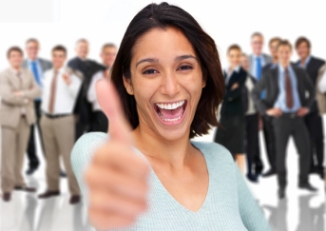What's your definition of employee engagement?
 Jeff Toister
Jeff Toister  Monday, April 23, 2012 at 1:08PM |
Monday, April 23, 2012 at 1:08PM |  Employee engagement is a hot topic. Engaged employees are more productive and loyal, while disengaged employees can hurt your company's bottom line. And, research shows that employee engagement and customer engagement are highly correlated.
Employee engagement is a hot topic. Engaged employees are more productive and loyal, while disengaged employees can hurt your company's bottom line. And, research shows that employee engagement and customer engagement are highly correlated.
You won't find much debate about the merits of employee engagement. However, you will see disagreement when it comes to finding a common definition of employee engagement. Which leads to my question:
What is employee engagement?
Here are three different definitions from respected sources:
Gallup
The Gallup Organization may be among the best known of the big consulting and research firms that focus on employee engagement. However, finding their definition takes a little bit of work. The best I could find was this: "Engaged employees are involved in and enthusiastic about their work." (Link to article reference.) There are many great resources on the Employee Engagement section of their website, but I couldn't find a definition.
BlessingWhite
Page 4 of the BlessingWhite 2011 Employee Engagement Report defines employee engagement as the intersection of job satisfaction and job contribution. (Download their free report here.) This seems to be an important distinction from the Gallup model which focuses more on employees' emotional connections to their work. The BlessingWhite model also takes into account employees' contributions to organizational success.
DecisionWise
Tracy Maylett, DecisionWise's CEO, co-authored an article on employee engagement with Julie Nielson, the American Society for Training and Development's (ASTD's) Senior Director of Human Resources and Organizational Learning. The article, titled "There Is No Cookie Cutter Approach to Engagement," appeared in the April 2012 issue of T&D Magazine and argued that employee engagement is the intersection of an employee's job satisfaction, effectiveness, and motivation. Their model seems like a hybrid of the Gallup and BlessingWhite approaches. Maylett and Nielson are hosting a free webinar on April 26 called "Halting the Engagement Exodus" where you can learn more. (Click here to register.)
Why does it matter?
This is by no means an exhaustive list, but there is a potential for confusion when we're all talking about engagement but we mean different things. Here's why I think this is important:
- No matter what the definition, research has shown that employee engagement is a critical driver of organizational success.
- If we want to improve something, we should gain agreement on what "it" is.
- Your definition will affect your strategy for getting better results.
My Definition, and a Resource
I prefer to think of employee engagement as the extent to which an employee is deliberately contributing to organizational success. This would be the "contribution" aspect of the BlessingWhite model or the "effectiveness" component of the DecisionWise model. I don't disagree that job satisfaction, motivation, and an emotional connection to the company are important, but I also view them as drivers of an employee's willingness to help their company succeed.
When I work with my own clients on employee engagement issues, I will often use a simple alignment assessment to start the conversation. This assessment looks at how well the organization's core "people processes" are aligned with organizational goals. The closer the alignment, the more likely you are to have engaged employees. Try the assessment out for yourself.
What's your definition?
Please comment on this post with your definition of employee engagement. Do you agree with one of the three mentioned above? Or, perhaps you have another twist you can share? Please share links if available!




